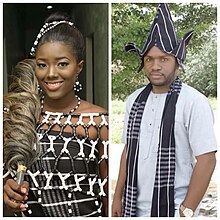Draft:TIV Traditional Marriage
| Submission declined on 1 November 2023 by Vanderwaalforces (talk). The proposed article does not have sufficient content to require an article of its own, but it could be merged into the existing article at Tiv people. Since anyone can edit Wikipedia, you are welcome to add that information yourself. Thank you.
Where to get help
How to improve a draft
You can also browse Wikipedia:Featured articles and Wikipedia:Good articles to find examples of Wikipedia's best writing on topics similar to your proposed article. Improving your odds of a speedy review To improve your odds of a faster review, tag your draft with relevant WikiProject tags using the button below. This will let reviewers know a new draft has been submitted in their area of interest. For instance, if you wrote about a female astronomer, you would want to add the Biography, Astronomy, and Women scientists tags. Editor resources
|  |
 Tiv bride and groom. | |
| Regions with significant populations | |
|---|---|
| Benue State (Nigeria) | |
| Languages | |
| Tiv | |
| Religion | |
| Christianity |
Tiv is an ethnic group in Nigeria.[1]. They are the predominant ethnic group in Benue State, where their population is at its maximum. The Tiv people's traditional clothing is fully striped in black and white. This outfit is known as "Anger"[1]. Their original costume also includes white and black beads.[1] The Tiv population in Benue State is dispersed over fourteen (14) local government areas,[2] which include: Logo Local Government Area, Ukum Local Government Area, Katsina-Ala Local Government Area, Ushongo Local Government Area, Kwande Local Government Area, Vandeikya Local Government Area, Konshisha Local Government Area, Gboko Local Government Area, Buruku Local Government Area, Gwer Local Government Area, Makurdi Local Government Area, and Guma Local Government Area[2] Nationally, the Tiv people of Nigeria, who are native to Benue State and its bordering states of Plateau, Nasarawa to the north, and Taraba to the north-east, share the same cultural legacy.[2][3]
Traditional Marriage in Tiv Culture[edit]
Marriage is, of course, one of the prominent features of Tiv culture, which is quite rich and developed in many areas. Traditional marriage among the Tiv is still seen as a significant cultural occasion.[4] Tiv's marriage is not just the union between a husband and a wife but the entire family.[5]
Different Forms of marriage in Tiv land[edit]
Yamshe: This type of marriage was practiced by the fore-fathers and involves the exchange of sisters to marry couples. Previously, two men might swap sisters or families, exchanging daughters for spouses.[5] A man looking for a wife who comes across another looking for a wife will exchange daughters or sisters.[1]
Kwase Tsuen: This is a union induced by captivity. A man would kidnap a girl forcefully, or a family would do it for their son. It is used in some remote Tiv areas.[5][1]
Iye: In Tiv land, courtship or dating is the norm. The man meets a girl, pays her additional visits, and gives his family some things. Sometimes the girl and the man decide to run away secretly with the intention of getting married without parental consent, and sometimes the girl is taken home after the man pays the bride price.[5]
Kwase- Kemen: This is a type of marriage that is currently practiced in Tiv Land: bride-price marriage. After extensive courtship (Iye), the man visits the girl's family, pays the money, and offers the gifts the girl's family listed.[5]
In 1927, the intricate Tiv system of trade marriage was abolished and bride-wealth marriages took it's place[6]
Tiv's Traditional Marriage attire[edit]
Tiv people dress in vibrant colors, and the groom and bride's outfit appears to be among the most significant aspects of a wedding. The garments produced with A'nger material have black and white stripes, which are the most constant feature[7]. Without a variety of accessories, such as headpieces, bracelets, or necklaces, wedding apparel is also unattainable. Beads in shades of black and white are the most common type.[8]
References[edit]
- ^ a b c d e Nigeria, Good (2020-03-02). "TIV Ethnic Group". Good Nigeria. Retrieved 2023-05-18.
- ^ a b c "The Tiv People of Benue State – I am Benue". Retrieved 2023-05-18.
- ^ "Tiv Culture: A brief walk into the lives of one of the world's greatest storytellers". Pulse Nigeria. 2022-07-29. Retrieved 2023-05-19.
- ^ Fakunle, Mike (2022-03-21). "Traditional Marriage Requirements in Tiv, Benue State (2023)". Nigerian Infofinder. Retrieved 2023-05-19.
- ^ a b c d e "Traditional Marriage – Tiv Nation". Retrieved 2023-05-19.
- ^ "Tiv | Traditional Culture, Social Structure & Rituals | Britannica". www.britannica.com. Retrieved 2023-10-05.
- ^ "TIV Ethnic Group - Good Nigeria". goodnigeria.com. Retrieved 2023-10-06.
- ^ Fakunle, Mike (2022-03-21). "Traditional Marriage Requirements in Tiv, Benue State (2023)". Nigerian Infofinder. Retrieved 2023-10-05.
